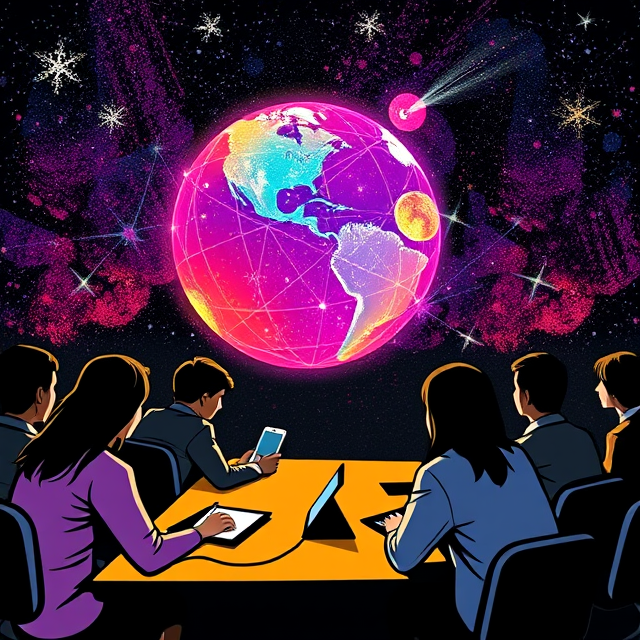In recent years, technology has significantly transformed the education landscape. Role of Virtual One of the most exciting developments is the integration of Virtual Reality (VR) and Augmented Reality (AR) into learning environments. These technologies have the potential to revolutionize traditional teaching methods by providing immersive and interactive experiences that enhance student engagement, comprehension, and retention.
What is Virtual and Augmented Reality?
Virtual Reality (VR) creates a fully immersive digital environment where users can interact with a simulated world using VR headsets and motion tracking devices. Role of Virtual It allows students to experience and engage with content in a way that feels real, making abstract concepts more tangible.
Augmented Reality (AR), on the other hand, overlays digital content onto the real world through devices such as smartphones, tablets, and AR glasses. This technology enhances real-world experiences by providing additional layers of information and interactivity.
Benefits of VR and AR in Education
1. Enhanced Engagement and Motivation
Traditional classroom settings can sometimes fail to capture students’ attention. Role of Virtual VR and AR offer an engaging and interactive way to present educational material, making learning more enjoyable and motivating students to participate actively.
2. Improved Retention and Understanding
Studies suggest that immersive learning experiences lead to better retention of information. With VR, students can visualize complex concepts, such as the human anatomy or historical events, in a way that enhances comprehension and long-term memory.
3. Experiential Learning Opportunities
VR allows students to engage in experiential learning by simulating real-life scenarios. Role of Virtual For example, medical students can perform virtual surgeries, engineering students can explore complex structures, and history students can visit ancient civilizations.
4. Safe Learning Environment
Certain subjects, such as chemistry and engineering, involve risks when conducted in real life. VR provides a safe, controlled environment where students can practice experiments and procedures without any physical danger.
5. Personalized Learning Experiences
AR and VR technologies can adapt to individual learning styles and paces. Personalized virtual tutors and interactive content help cater to students’ unique needs, ensuring that they grasp concepts effectively.
6. Bridging the Gap Between Theory and Practice
One of the most significant challenges in education is applying theoretical knowledge to practical situations. VR and AR provide opportunities for students to apply what they’ve learned in real-world scenarios, bridging this gap effectively.
Applications of VR and AR in Education
1. Virtual Field Trips
VR enables students to explore distant locations without leaving the classroom. They can visit historical landmarks, explore space, or dive into the ocean, enhancing their understanding of geography, science, and history.
2. STEM Education
Subjects like Science, Technology, Engineering, and Mathematics (STEM) benefit greatly from AR and VR. Interactive simulations help students visualize complex scientific processes, conduct experiments, and understand intricate engineering designs.
3. Special Education
For students with disabilities, AR and VR offer customized learning experiences that cater to their specific needs. Interactive visuals, audio cues, and adaptive interfaces make learning more accessible and inclusive.
4. Language Learning
Immersive language learning through VR can place students in real-world conversational settings, improving their fluency and comprehension in a foreign language by interacting with virtual characters.
5. Professional Training
Beyond traditional education, VR and AR play a crucial role in professional training, such as military simulations, pilot training, and corporate onboarding programs, offering realistic practice without real-world risks.
Challenges of Implementing VR and AR in Education
Despite the numerous benefits, the adoption of VR and AR in education comes with challenges:
- High Costs: The initial investment in VR headsets, AR devices, and content development can be costly for educational institutions.
- Technical Limitations: Not all schools have the infrastructure or technical expertise to implement and maintain VR/AR technologies effectively.
- Content Development: Creating high-quality, curriculum-aligned VR/AR content requires time and resources.
- Health Concerns: Prolonged use of VR headsets may cause discomfort, eye strain, or motion sickness in some students.
The Future of VR and AR in Education
As technology continues to advance, the future of VR and AR in education looks promising. With ongoing developments in artificial intelligence, cloud computing, and 5G connectivity, these technologies will become more accessible and cost-effective. In the coming years, we can expect:
- More affordable VR/AR hardware for schools and students.
- Increased collaboration between educators and tech companies to develop curriculum-aligned content.
- Enhanced AI-driven personalized learning experiences.
- Wider adoption of VR and AR across all educational levels and disciplines.
Conclusion
Virtual and Augmented Reality are transforming the way students learn by offering immersive, interactive, and personalized experiences. While challenges exist, the benefits outweigh them, making VR and AR valuable tools for enhancing education in the 21st century. As technology evolves, integrating these innovations into classrooms will create more engaging and effective learning environments for students worldwide.
